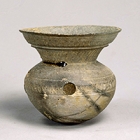Japanese Archaeology and Special Exhibition (Heiseikan) Japanese Archaeology Gallery
March 11, 2014 (Tue) - September 7, 2014 (Sun)
Among the pottery of the Kofun period (ca. 3rd-7th century), there is unglazed pottery known as Haji ware which continued to be produced until the Heian period (794-1192). This was made by firing in an open fire, as Yayoi pottery was in the previous period. Another type is Sue stoneware, which was fired in anagama (single chamber) kilns made by digging holes into sloped ground. Both the terms "Haji" and "Sue" derive from what pottery was called during the Heian period. Haji ware presents a reddish-brown color from being oxidized by flames at a temperature of approximately 850゚C. Flame temperatures for firing Sue stoneware rise to above 1000゚C, which deoxidizes the stoneware to give it firmness and results in a dark blue-gray or charcoal-white color. Technologies for Sue stoneware were introduced from the end of the 4th century onward through Korean stoneware methods utilizing potter's wheels and kilns, methods which originated in the production of Chinese gray pottery. Since Sue stoneware was easily damaged by heat, the main vessel types developed were limited to items not intended for cooking, such as jars for preserving food, or bowls, stemmed bowls, pitchers, jar stands, and footed jars for presenting food, as well as ornamented Sue stoneware with various decorations. Unique types of vessel, such as those in the shapes of birds and houses, were also made.
From In the 5th century to the Heian period, more than 1000 anagama kilns were active in the southern area of the Osaka plains, forming the central site of Sue stoneware pottery production. After the 6th century, since production areas stretched to the Tokai region and northern Kyushu, Sue stoneware spread widely and developed varied vessel types for use in funeral rituals and burial in kofun tumuli.
This exhibition focuses on Sue stoneware from the Kibi region, which was one of the important centers of Sue stoneware production. The vessels on display are excellent examples of ornamented Sue stoneware.

